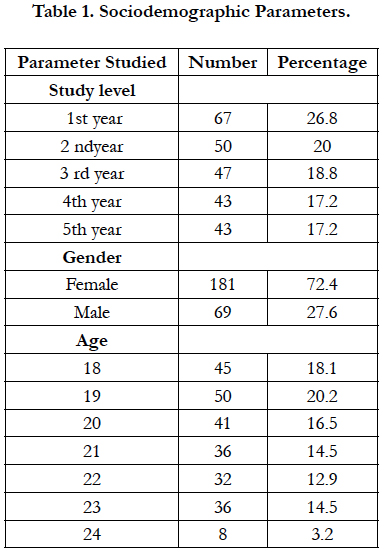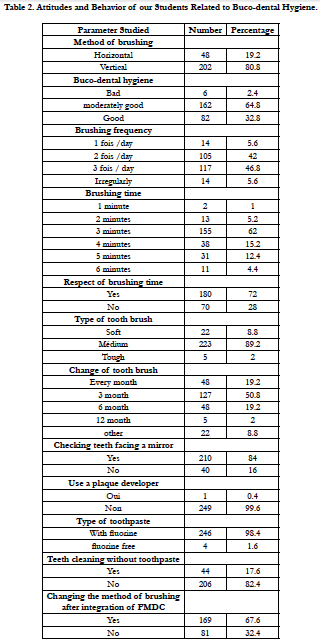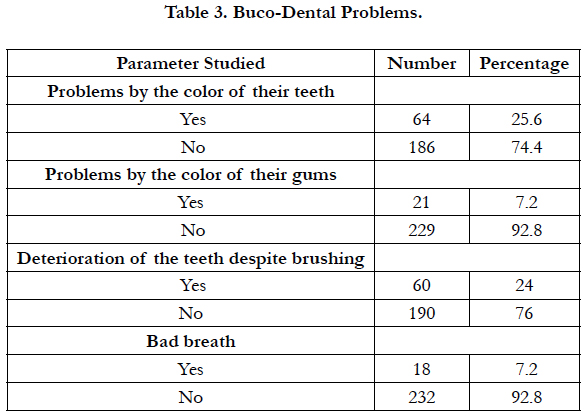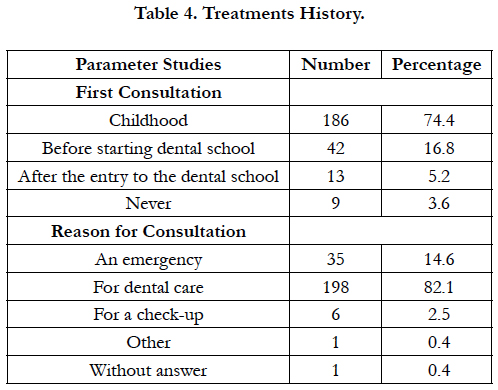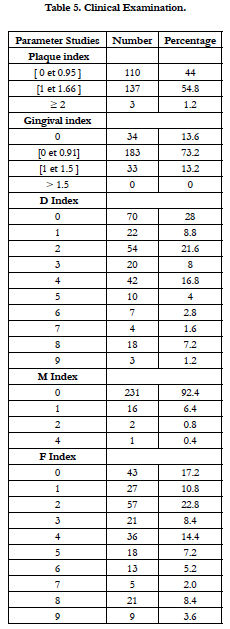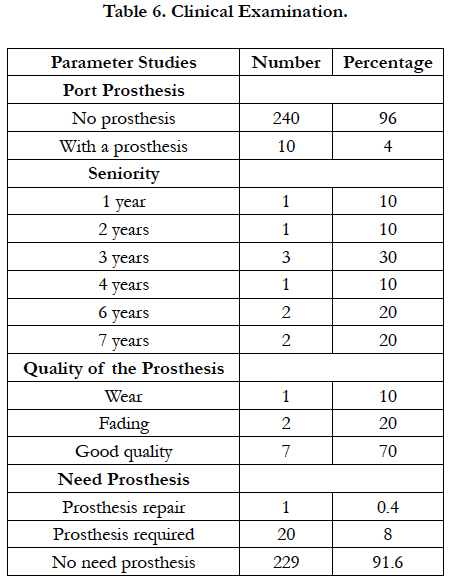Oral Health of Dental Students in Casablanca
Rimaoui S1, Rahmaoui M2, Hamza M3, Bennani A4*
1 Doctor, Department of Removable Prosthodontics, Faculty of Dentistry, University Hassan II, Casablanca, Morocco.
2 Doctor, Department of Pedodontics, Faculty of Dentistry, University Hassan II, Casablanca, Morocco.
3 Professor of Department of Epidemiology and Biostatistics, Faculty of Dentistry, University, Hassan II, Casablanca, Morocco.
4 Professor of Department of Fixed Prosthodontics, Faculty of Dentistry, University Hassan II, Casablanca, Morocco.
*Corresponding Author
Bennani Anas,
Professor of Department of Fixed Prosthodontics,
Faculty of Dentistry, University Hassan II, Casablanca, Morocco.
Tel: 00 212 661 327 303 / 00 212 522 278985
E-mail: anasbennani2004@yahoo.fr
Received: November 21, 2017; Accepted: December 18, 2017; Published: December 20, 2017
Citation:Rimaoui S, Rahmaoui M, Hamza M, Bennani A. Oral health of Dental Students in Casablanca. Int J Dentistry Oral Sci. 2017;4(12):557-564.doi: dx.doi.org/10.19070/2377-8075-17000110
Copyright: Bennani A©2017. This is an open-access article distributed under the terms of the Creative Commons Attribution License, which permits unrestricted use, distribution and reproduction in any medium, provided the original author and source are credited.
Abstract
The aim of this study is to evaluate the knowledge, attitudes regarding hygiene and oral health and oral health of students of the faculty of dentistry of Casablanca.
Materials and Method: The data collection is based on the behavioral inventory of the HIROCHIMA Dental University (HU-DBI), this questionnaire was supplemented by other questions related to hygiene and oral health attitudes, Dental examination and a detailed clinical examination. A total of 250 students (20.4 ± 1.8 average age) completed the questionnaire and were examined.
Results: Of the 250 students, 89% of the students brush their teeth twice to 3 a day, 44% use other means of HBD than the toothbrush. 67% of students changed their oral hygiene behaviors after integration into the faculty. 43% of students have a plaque index between 0 and 1 and 73% of students have a gingival index between 0 and 1. Regarding the wearing of prosthesis, 96% of students do not wear prostheses and 8% need a fixed prosthesis.
Discussion: The analysis and comparison of the results reveals the motivation of the students of the FMDC in terms of oral hygiene. Some indicators of the survey show the impact of clinical and theoretical training on the health status of students in dentistry. By comparing our results with other countries, we find a similarity of the results of the parameters studied.
Conclusion: Teaching at the Faculty of Dentistry in Casablanca and knowledge of oral hygiene seem to improve the practice of oral hygiene among dental students.
2.Introduction
3.Materials and Method
4.Results
4.1 Buco-Dental Hygiene
4.2 Buco-Dental Problems
4.3 Informations Source on Buco-Dental Health
4.4 Treatments History
4.5 Attitudes and Behavior in Relation to Buco-Dental Health
4.6 Buco-Dental Clinical Exam
5.Discussion
5.1 Size of the Study Group
5.2 Clinical Exam
6.Conclusion
7.References
Keywords
Dental Students; Dental Hygiene, Attitudes in Oral Health; Clinical Examination; Casablanca.
Introduction
Buco-dental diseases (BDD) are one of the most frequent problems in the majority of countries all around the world. In affected individuals, BDD can adversely affect (sometimes seriously) the general condition and the quality of life. So BDD are considered a real public health problem.
In developping countries, a satisfactory buco-dental health is difficult to achieve in the general population because of an evident lack of dental care units and facilities. In the other hand, prevention of BDD remains the better means to maintain a good buco-dental health. So, there is a real need that dental health care workers in general give to patients some recommendations related to preventive measures for a good buco-dental condition.
As far as buco-dental hygiene is concerned, in general practice, these preventive measures and the acquisition of good attitudes and behavior remain the challenge that the dentist have to be confronted with. So, the attitudes, the competency and the knowledge of the dentists play an important role, not only during the dental treatments but also for the prevention of BDD, when giving advices to patients about the dangers of a lack of buco-dental hygiene.
Because they will have to provide buco-dental cares in the future, students in dental medicine represent a pertinent group to study when making investigations in this subject. Dental students need to have knowledge and skills related to preventive dentistry. In this view, a minimal knowledge in basic informations on bucodental health and adequate preventive procedures, is a fundamental prerequisite in order to promote a preventive behavior when dealing with oral health. The behavioral inventory of the dental university of Hiroshima (HU-DBI) is a questionnaire devised by Kawamura and that allows to understand the buco-dental health perception of the patients. The HU-DBI is in japanese in its original form but have been translated in english with a good fiability [10]. Since then, this questionnaire have been also translated in many langages and used in a great number of dental medicine studies as an evaluation tool of the attitudes, behavior and perception of buco-dental health by students [11].
For the purpose of this study, we made some changes in the questionnaire and added other questions related to hygiene and attitudes in buco-dental health. Finally, we proceed to a detailled clinical exam.
Many studies have evaluated the buco-dental attitudes and the behavior of dental medical students. But just a small number of them have been focused on dental students buco-dental condition.
The goals of the present study were as follow:
- To study the behavior and attitudes related to buco-dental health of our students,
- To assess their buco-dental condition.
Materials and Method
The present cross-transversal survey have been conducted at the faculty of dental medicine of Casablanca, Kingdom of Morocco, during the period running from may to october, 2016. The study launched students in all the five years of studies. In our faculty, a preclinical formation is made during the first 3 years and a clinical formation during the last 2 years. The students learn the great part of their knowledge on preventive dentistry and dental hygiene during the second year of study, when attending lessons in pedodontics. Since the fourth year, the students give cares to patients and participate to the buco-dental prevention schedule when visiting, once a week, youngs in primary schools of our city.
For data collection, we conceived a questionnaire with 24 questions divided in 4 items:
- The first item was for socio-demographic characteristics;
- The second item for history of dental treatments;
- The third item for attitudes in dental health;
- The fourth was the clinical exam for buco-dental condition.
In this last item (clinical exam), the following variables were to be evaluated:
- Plaque index;
- Gingival index;
- DMF index;
- The wearing of a prothesis;
- The prosthesis quality;
- The prosthesis need.
Inclusion to the study was effective after informed consent of the participant. The answers to the questionnaire were reported anonymously.
An exam plate was the principal materials used for the clinical exam in this survey, containning a mirror, a cannula n°17, a parodontal cannula, one-use gloves and masks.
Before the biginning of the survey, we made a pre-survey in 10 students (2 for every class-year) to test the value of the questionnaire and the acceptatbility of the survey by the students. The students were meet in the Casablanca Center of Visit and Dental Treatment (CVDT). The clinicial exams were made in the conjoined prothesis unit of the CVDT.
During the study, students attitudes varied because some of them asked to keep the questionnaire with them as they needed some time to respond to the different questions, when others filled it up immediately. All the clinical exams were done by the same practitioner. Data analysis was done using Epi info 6 sofware.
Results
250 students with a mean age of 20.4 ± 1.8 and a sex ratio (women: 181, 72.4 % ; men : 69, 27.6 %) of 2.62 in favor of women, have been included in this study. Table 1 shows the students distribution in relation to the year of school, sex and age.
The majority of students (64.8 %) estimated that their bucodental hygiene was moderately good. When brushing their teeth, 80.8% of students used the vertical method of brushing. Also, 60.8% of them have learnt how to brush their teeth at the faculty and 67.6% have changed their method of brushing the teeth after admission in the dental faculty. 88.8% practise the exercice of brushing 2 to 3 times per day. The great majority (89.2%) use a medium type of toothbrush.
Table 2 shows attitudes and behavior of our students related to buco-dental hygiene.
25.6% of the participants indicated that they were embarrassed by the color of their teeth and 8.4 % by the color of their gums. 7.2% were affected by a bad breath.
61.2 % of the students indicated that the mean source of informations on buco-dental health available for them was the lessons provided at the faculty (Table 3).
74.4% of the participants had their first visit to the dentist during childhood; 82.5 % have already visit a dentist but 3.6% have never done that (Table 4).
50.8 % said that they control their buco-dental state once a year and 84 % estimate that their buco-dental state have improved owing to their admission in the dental faculty.
The clinical exam showed that the plate index was between 0.04 and 2.08, with a mean value of 0.96 (0.39). The gingival index was between 0 and 1.5 (mean : 0.35) (0.39). The number of teeth with caries was between 0 and 9 (mean : 2.596) (2.453); that of missing teeth between 0 and 4 (mean : 0.09) (0.38). Also, the number of filled teeth was between 0 and 9 (mean: 3.2) (2.61). Only 4 % of the participants wore a prothesis. (Table 5).
Discussion
As students in dental medicine are the future providers of bucodental health cares, it seems very important to analyze the oral health attitudes and behavior of these students.
The study group had 250 students chosen randomly among the 693 students of the faculty ; but with the respect of the different ratios of students in very class year.
Students of the study group were aged between 18 and 24 years. Studies in dental surgery last 5 years. Because students start their studies at 18 after obtaining the baccalauréat, they will be graduated in dental surgery at age 24.
The mean age of students of the casablanca faculty of dental medicine is 20.4 years. Similar results on dental students age have been reported in 2002 by Cortes et al., [5], for students of the faculty of dental medicine in Barcelona, with a mean age of 21.1 years [5].
Female sex was predominant in this study (72.4%, almost the ¾ of the study group). As in our study, others like Malbrunot et al., [13] have also reported such female sex prevalence (70% of women).
44.8% of the students parents were executives or high-ranking officials. May be the socio-economic level of the students famillies interfere with the level of bucodental health and the good hygiene attitudes noted. In a study of Sharda AJ [2], the impact of socio-economic status was low as all the participants belonged to the same social class.
98 % of the students felt some satisfaction about their buco-dental hygiene. They also estimated that their hygiene was moderately good or good. Others have already reported such results [5], with very keen and satisfied dental students about their buco-dental hygiene.
In 50 % of the study population, the source of informations in relation to buco-dental health proceeding from their parents or their surgeon dentist. In a study including chinese and british students, Komabayashi et al., [12] reported that 10 % and 31 % of chinese and british have never had professionnal instructions in relation to oral hygiene, respectively.
80 % of the students used the vertical method when brushing their teeth, the method they learned at the faculty. This is a proof that the formation they receive is of benefit and corrects the buco-dental hygiene practices, if wrong. In the study of Cortès et al., [5], 100 % of the participants reported that dental formation helped them to improve their method of brushing the teeth.
89 % of the participants said that they brush their teeth 2 to 3 times per day. This frequency is greater than that observed in studies from Ankara (Turkey) and Bangalore (India) (74.1 and 73.6 %, respectively) [8, 17]. According to the recommendations of the French Union of buco-dental health (UFSBD: Union Française de Santé Bucco-Dentaire) of november 2013, 2 brushings of the teeth per day are sufficient to ensure a good buco-dental hygiene [16].
The former recommendations (teeth brushing 3 times per day) were followed by a small number of people only. Studies in France have shown that lower than 1 french over 4 respected the recommendation of 3-times-per-day of teeth brushing [16]. Our results showed that the attitudes of our students were satisfactory and comform to the new established recommendations.
62% of the students reported a brushing duration of 3 minutes, which seems fair.
89% of our students declared that they are using a « medium » type of toothbrush. For a complete cleaning of the teeth and in order to prevent tartar accumulation and subsequent development of the plaque, the choice of the suitable toothbrush should be done according to the needs and the individual oral condition (paradontal disease, orthodontic system, dental and/or implant supported prothesis). The toothbrush choice seems correct in our population. In 2 studies including students from USA and Hong Kong, Kawamu et al., [14, 15] reported that 11 and 12 % of the participants still continued to use a childhood specimen of toothbrush, respectively.
Half of our study group used to change the toothbrush every 3 months. In the study of Sharda and Shetty among dental students of Rajasthan in India, 96.2 used to change their toothbrush just only when it is worn [2].
It is advised, when brushing the teeth, to verify the brushing process in a mirror, in a well enlightened room so one could check that all the plaque have been removed. In this study, 84 % of the participants declared that they respect this advice. This rate is very satisfactory and quite similar to those reported in other studies from Istanbul (88.8 %) [9] and Ankara (78.8 %) [8] in Turkey, Athena (87 %) [3] in Greece, and Irbid in Jordan (79 %) [1].
0.4 % of the students affirmed that they use a plaque revealer. This rate is very low when comparing it with those noted in studies from Hiroshima, Sichuan or Great Britain (75; 51.5 and 55%, respectively [3, 12]).
The use of adjuvants of the brushing is necessary in order to perfect the buco- dental hygiene. Among the 44 % of the study group who use such adjuvants, 68 % have recourse to the dental loss and another 28 % make mouthwashes. In a similary study made in Ankara in 2008, Peker et Alkurt [8] showed that 32 % and 13.7 % of the study group used dental loss and mouthwashes as other means of buco-dental hygiene, respectively.
17.6 of the students estimated that they could have cleaned their teeth without toothpaste. Those results are in accordance with previous studies in Istanbul [9] and athena [3] (17.1 % and 17 %, respectively). This reflects the importance to initiate the population to the combined method of brushing, with a chemical action of the toothpaste and a mechanical one of the brush.
In this study, 67.6 % improved their brushing method when learning in our faculty. The choice to be a dentist has an impact on someone’s interest when dealing with his buco-dental health. It also seems that adhesion to the formation in buco-dental hygiene and prevention was good at an individual level, founding expres sion in performance and motivation. Lessons on caries process and on brushing methods in social preventive odontology and buco-dental prevention are teached in the second year. Ahead et al., [1], in their study, reported that relative to oral health, dental students had more positive attitudes than dental prothesists [1].
The change of teeth color can be very embarrassant for the affected individual as it can hamper self-confidence and sociability. Many potential aetiologic factors have been recognized, especially tobacco, drugs, fluor excess, some foods and finally lack of bucodental hygiene. The rate of 25.6 % observed in our study remains low in comparison to other studies (33.2 to 92 %) [3, 8, 12, 17].
The rate of this kind of embarrassment was low in this study and comparison with the results of other studies exhibit rates that are quite similar (9 % and 6.1 % in the Athena and Istanbul studies, respectively) [3, 9].
24 % of the the study group suffer for some teeth deterioration despite brushing and this rate is similar to that reported in the study of Hiroshima in Japan (30 %) [3]. This can be explained by the non-respect of good eating habits and principles. As nutrition has an impact on buco-dental health, it is advised to divide the food consumption in 3 meals taken at regular horaries, to prefer water and milk instead of acid drinks and not to nibble. Because of lack of time and stress, the great majority of the participants did not respect those recommendations. It is then important to heighten the importance of a regular and balanced diet. Also, students must be sensitized about the need to lower the frequency of consumption of sugar and to avoid nibbles, especially during exam sessions.
Bad breath can become a veritable social complex and affect human relationships. Many studies have presented bad breath as a source of worrying [12, 17]. In one study on dental students made at Bangalore in 2011, 76 % of the participants indicated they were worried about bad breath [12]. Also, in another study, 68 % of chinese dental students worried about their oral breath [17]. The rate of 7.2 % of cases having a bad breath in this study seems satisfactory.
82 % of the participants visited the dentist for the first time during the childhood, for teeth cares. For parents, dental prevention is not a priority in our country. So restorative dentistry holds a more important place than preventive dentistry.
90.4 % of the students visit the dentist for a regular control of their oral state: 39.6 make a control every 6 months and another 50.8 % every year. According to the Oral Health Plan of the New York State [16], a yearly visit to the dentist is required. Also, according to AAPD recommendations [7], regular visit to health care professionals should be done in a preventive perspective and be useful to give instructions in oral hygiene and take off the bacterial plaque. Our results are consistant with these established recommendations.
84 % of our group study reported an improvement in their buco-dental health after admission in the dental faculty. This represents an important positive point, as formation has had an impact on their oral health condition at an individual level. ShardaetShetty also observed such positive correlation between formation in the dental faculty and acquisition of good attitudes and behavior in oral health by the students [2].
44 % of the participants had a plate index between 0 and 1 and only one participant had a plate index greater than 2. This reflects the positive attitudes of the students included in the study for a good buco-dental hygiene.
It was between 0 and 1 in the great majority of the participants, indicating a good gingival condition.
The mean DMF index was 5.87; with a mean D, M and F indexes of 2.72; 0.45 and 2.83, respectively. According to world health organization [4], in almost all african countries, adult individuals have a CAO index that is between 5 and 8.9.
DMF index remains satisfactory in our study group. Also, in comparison with the general population, the good dental condition observed in our study population, seems to reflect the positive impact of the formation and learnings provided in our faculty in the specific context of bucco-dental hygiene.
96 % of the particpants do not wear a prothesis but 8 % need a fixed prothesis. In one study made at Dakar (Sénégal) [6] in 2007 among dental students, 47 % of the participants needed a prosthetic rehabilitation. Our results are more favorable, and this can be a proof that dental caries are managed at time and that eventual dental delabrements or extractions in relation with progression of the caries are infrequent events.
According to the results, the following conclusions can be taken about buco-dental health attitudes and behavior of dental students in our context:
1. During medical dental studies, the students feel the necessity to put into practice the good buco-dental attitudes and behavior they are learning in their formation.
2. Our students exhibit satisfactory results, that can almost be better than those reported in many other studies on medical dental students.
However, a small subgroup of students need to better cope with good oral attitudes, as 5.6 % of students brush their teeth irregularly and 2 % change their brush only once a year. Moreover, 9.6 % estimate that control of their buco-dental condition is not necessary and another 3.6 % have never visit a dentist.
Hygiene remains the main measure for maintaining satisfactory oral health. On the other hand, it is increasingly recognized that teaching and education in this field are practically the only means of directing the behavior of subjects for better oral hygiene.
We conducted an investigation at the faculty of dentistry in Casablanca exploring the dental status of students, future dental surgeons who will be charged with the mission of promoting oral health.
This work reflects the impact of education on the hygiene and oral hygiene habits of students with their patients. This has been demonstrated by the improvement of the student plaque index and CAO index and the Implementation of proper hygiene practices.
We conclude that students have the potential to take charge of sensitizing the general public and show the importance of hygiene in maintaining good oral health.
References
- Al-Wahadni AM , Al-Omiri MK, Kawamura M. Differences in self-reported oral health behavior between dental students and dental technology/dental hygiene students in Jordan. J Oral Sci.2004 Sep;46(3):191-197.PubMed PMID:15508753.
- Sharda AJ, Shetty S. A comparative study of oral health knowledge, attitude and behaviour of first and final year dental students of Udaipur city, Rajasthan, India. Int J Dent Hyg.2008 Nov;6(4):347-353. PubMed PMID: 19138186.
- Polychronopoulou A, Kawamura M . Oral self-care behaviours: comparing Greek and Japanese dental students. Eur J Dent Educ.2005 Nov;9(4):164– 170.PubMed PMID: 16194248.
- Cisse D, Kane AW, Faye B, Toure B, Sarr M, Diop M, et al. Food habits and oral hygiene of students. Investigation of 150 students in university housing. Odontostomatol Trop. 2001 Mar; 24(93):11-15. PubMed PMID: 11484651.
- Cortes FJ, Nevot C, Roman JM, Cuenca E. The evolution of dental health in dental students at the University of Barcelona. J Dent Educ.2002 Oct; 66(10):1203-1208. PubMed PMID: 12449215.
- Faye D, Cisse D, Mbodj EB, Lo CM. Epidemiologic study of dental caries among students on the campus of the University of Dakar. Odontostomatol Trop. 2007 Sep;30(119):29-36. PubMed PMID:18198816.
- Hyson JM. Women dentists: the origins. J Calif Dent Assoc. 2002 Jun;30(6):444-453. PubMed PMID:12519054.
- Peker I, Alkurt MT. Oral Health Attitudes and Behavior among a Group of Turkish Dental Students. Eur J Dent. 2009 Jan;3(1):24-31. PubMed PMID: 2647956.
- Peker K, Uysal O, Bermek G. Dental Training and Changes in Oral Health Attitudes and Behaviors in Istanbul Dental Students. J of Dent Educ. 2010 Sep;74(9):1017-23. PubMed PMID: 20837744.
- Kawamura M. Dental behavioral science: the relation¬ship between perceptions of oral health and oral status in adults. J Hiroshima Univ Dent Soc.1988 Dec;20(2):273-86. PubMed PMID: 3271802.
- Kawamura M, Kawabata K, Sasahara H, Fukuda S, Iwa¬moto Y. Dental behavioral science: Part IX. Bilinguals’ responses to the dental behavioral inventory (HU-DBI) written in English and in Japanese. J Hiroshima Univ Dent Soc.1992;22:198-204. (In Japanese).
- Komabayashi T, Kwan SY, Hu DY, Kajiwara K, Sasahara H, Kawamura M. A comparative study of oral health attitudes and behaviour using the Hiroshima University – Dental Behaviour Inventory (HU-DBI) between dental students in Britain and China.J Oral Sci. 2005 Mar;47(1):1-7. PubMed PMID:15881222.
- Malbrunot X. Socio-economic situation of students in neurodontology in Clermont-Ferrand in 1991/1992 . [Thesis dental surgery]. Clermont-Ferrand. 1993.
- Kawamura M, Spadafora A, Kim KJ, Komabayashi T. Comparison of United States and Korean dental hygiene students using the Hiroshima University- Dental Behaviour Inventory (HU-DBI). Int Dent J. 2002 Jun;52(3):156-62. PubMed PMID:12090266.
- Kawamura M, Yip HK, Hu DY, Komabayashi T. Across-cultural comparison of dental health attitudes and behavior among freshman dental students in Japan, Hong Kong and West China. Int Dent J. 2001 Jun;51(3):159-63. PubMed PMID: 11563680.
- New recommendations. UFSBD updates its prevention strategies. Dental Practices. 2013; 19-39.
- Neeraja R, Kayalvizhi G, Sangeetha P. Oral Health Attitudes and Behavior among a Group of Dental Students in Bangalore, India. Eur J Dent 2011 Apr;5(2):163-167. PubMed PMID: 21494383; PubMed Central PMCID: PMC3075990.

